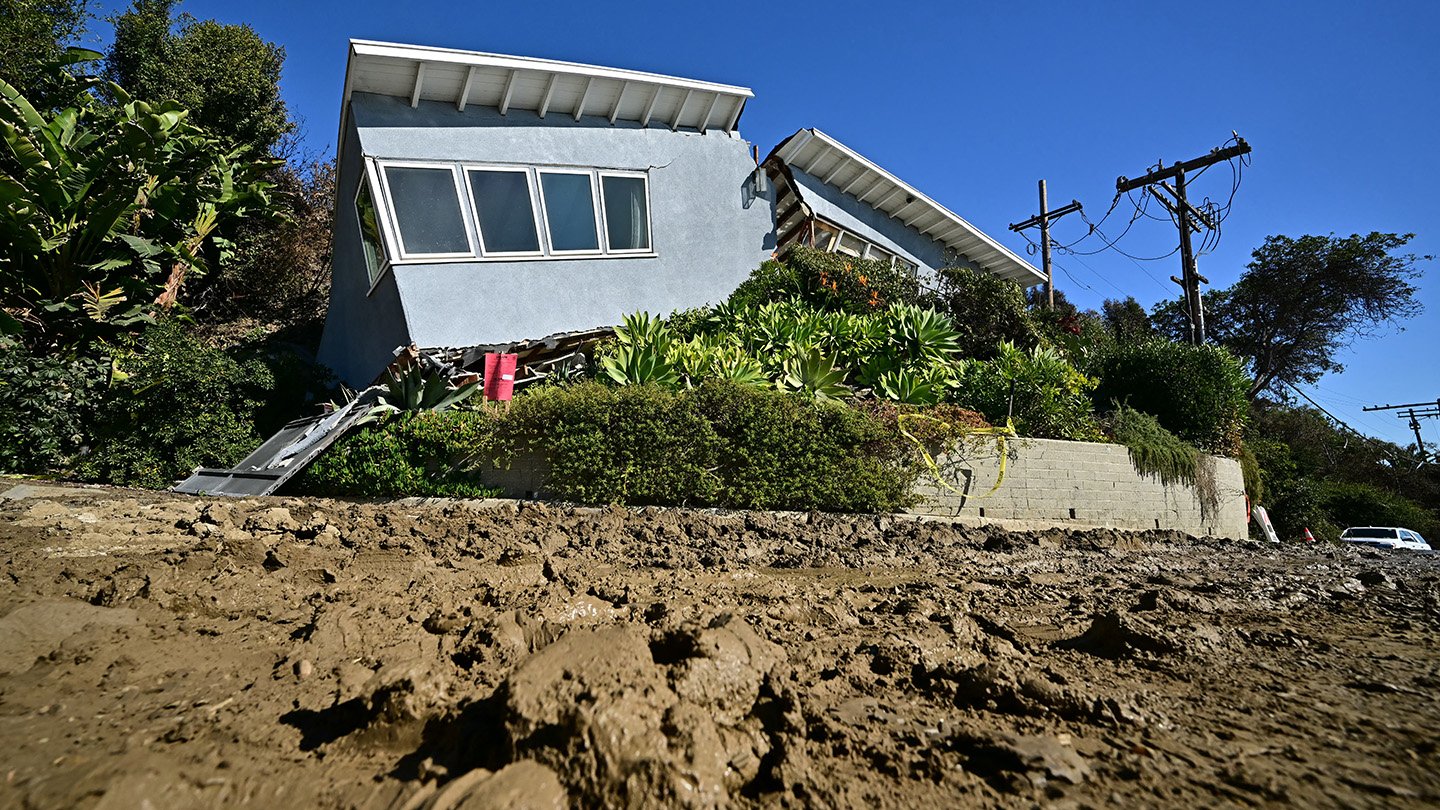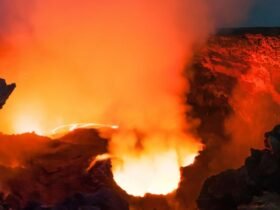The Los Angeles wildfires were still burning when scientists started scouting the freshly charred burn scars to search for signs of another danger that’s yet to come — roaring torrents of rock and mud and water that can sweep downhill with deadly momentum.
Triggered by intense bouts of rainfall, these debris flows — as well as flash floods — become more likely to occur after an intense wildfire has scorched an area’s slopes and vegetation. While flash floods can be devastating, debris flows surge with even greater ferocity. At least half of their volume is sediment, and it’s mixed with burned trees, cars and boulders.
“It’s like concrete moving downhill,” says geologist Jaime Kostelnik of the United States Geological Survey, who works in the Landslide Hazards Program in Golden, Colo. Because debris flows carry more material than flash floods, they can swell to be five times as high, she says. “Basically, a flood on steroids.”
Debris flows can hit speeds of about 56 kilometers per hour (35 miles per hour) as they careen vast distances through valleys, canyons and stream channels. Some gain so much momentum that they jump out of the channels they’re following and carve new paths. And in a flash, the debris can clog and overflow channels, too.
Due to their quick and powerful nature, debris flows can be devastating. In January 2018, debris flows in Montecito, Calif., killed 23 people and destroyed more than 100 homes just a month after the area had been burned by the Thomas fire.

The mountainous areas of Los Angeles County are known for hosting debris flows after intense blazes like the Palisades and Eaton fires. Debris flows occurred after the 2009 Station fire and 2016 San Gabriel Complex fire. Both of those blazes occurred near the ongoing Eaton fire, Kostelnik notes.
The terrain “is steep, and so that leads us to believe that the level of hazard is going to be quite high,” she says. With rain forecasted in the region on Saturday, emergency planners and responders will need to be on high alert.
Spurred by the possible threat, teams of scientists including Kostelnik are already assessing the extent to which the Los Angeles wildfires have primed the landscape for debris flows, even as new fires roar to life in the region. The researchers’ findings will inform decisions about when and where to warn people about the hazard. That’s crucial, because avoiding debris flows is the only fail-safe way to stay safe from them.
“This isn’t like flooding; you don’t put up sandbags to prevent things from happening,” Kostelnik says. “You can’t stop them.”
Assessing the risk for debris flows
In mid-January, the teams of scientists and engineers from federal and state agencies began surveying the areas burned by the Palisades and Eaton fires — the two largest of the recent Los Angeles wildfires — as well as the smaller Kenneth and Hurst fires.
A big reason for deploying to the burned areas so soon is that it’s already winter and debris flows are triggered by precipitation, says geologist Jeremy Lancaster of the California Geological Survey in Sacramento. “We assume that it’s going to rain soon because we’re in the middle of wet season, so we deploy rapidly.”
The field teams begin by reviewing satellite imagery from before and after the areas burned, studying changes in the vegetation cover. Destruction of vegetation can promote debris flows in a number of ways. As flames devour loose litter, twigs and leaves on the ground, the underlying soil loses a protective layer that shields it from erosion by splashing raindrops. That loss is exacerbated if standing vegetation is also incinerated, as plant leaves and stems that would otherwise intercept rainfall and hamper water flowing across the ground are lost to fire. And the destruction of plant root systems unbinds dirt and rocks, making them easier to move.
Then there’s how the fires alter the dirt. Gases released by burning litter and vegetation can seep into the ground where they cool and condense as a waxy substance that coats soil particles. These waxy particles form a hydrophobic layer that prevents water from percolating into the soil, resulting in more runoff on the surface. Additionally, heat from fires can disaggregate soil particles, promoting their erosion.
Following a fire, it can take just a brief bout of rainfall to trigger a flash flood, and if the rushing water picks up enough sediment, it can evolve into a debris flow. “These things can happen within minutes of a rainstorm happening,” Kostelnik says.
The Eaton fire’s burn scar poses high risk of debris flows
Guided by the satellite images, the teams enter the burned areas and seek out the most severely scorched patches, where they confirm the vegetation losses and sample the soils too, explains Lancaster, who scouted areas burned by the Palisades and Eaton fires last week.

“There’s a sense of urgency,” Lancaster says of the attitude shared by his team members in the field. “We know because of past experience that there’s sometime little time,” he says. Shortly after the Thomas fire in 2017, Lancaster was leading a similar field assessment of the debris flow risk there. “It literally rained four days into our deployment,” he recalls, “and that’s what caused the [debris flow] disaster.”
Working in the wake of ongoing wildfire demands some precautions. These include donning heat- and flame-resistant garb and boots, hauling around fire tents in case the team becomes trapped by flames and carrying radios so teams can keep updated on where the fires are headed, Lancaster says. “If the fire direction changes or a hot spot flares up close to us, we’re in direct connection with the incident command and so they can get us out of there really quick.”
In each fire’s burn scar, teams assess the soil burn severity, or how deeply and intensely the fires had burned into the ground.
“We’re typically worried about moderate to high burn severity,” Lancaster says. In moderately burned areas, up to 80 percent of litter has been burned away and fine roots near the surface may have been burned and killed, while areas burned at high severity have no litter or near surface roots remaining. “In chaparral dominated landscapes, we typically see a lot of moderate burn severity, he says. In the Eaton and Palisades fires’ burned areas, he and his team members discovered that the areas had burned mostly at moderate severity. They also observed hydrophobic soil layers had formed in both fires’ burn areas.
Between the two fire areas, the Eaton fire’s burn scar appears to pose greater risk for debris flows. “The Palisades burn area has much more gently sloping terrain and watersheds that flow to the ocean,” Lancaster explains, while “the Eaton [fire area] has extremely steep watersheds sloping down into Altadena, Pasadena, all the way out to Monrovia.”
Staying safe from debris flows
The teams’ field observations have already been entered into USGS computer programs that generate maps showing where debris flow hazard is greatest. Those maps, which are publicly available online, will later inform decisions by officials to issue alerts, warning and evacuation orders.
Emergency planners try to anticipate debris flows and flash floods using these hazard maps and weather forecasts. They watch for storms that could drop more than a certain amount of precipitation onto severely burned slopes. “Half an inch of rain in 30 minutes, or a quarter of an inch of rain in 15 minutes,” Kostelnik says. “So like, when you have to put your windshield wipers on high.”
Debris flows aren’t guaranteed at these rainfall rates, but they do become much more likely. “These rainfall thresholds were developed based on lots of field work and observations of the types of rain intensities that caused or triggered soil movement and erosion, and which turned into debris flows,” says hydrologist Jayme Laber of the National Weather Service, or NWS, in Oxnard, Calif.
Around 12 to 36 hours in advance of an incoming storm, the NWS may issue a watch alert to residents’ mobile devices if the forecasted rainfall could trigger debris flows and flash flooding. Once the storm has arrived and rain has started to hit the ground, the NWS may then issue a warning, which indicates that “it’s either happening now or it’s about to happen,” Laber says. “Don’t wait for the warning because … it could be zero minutes of lead time,” he says. “The watch is probably the best time to start taking your actions of being prepared.”
Drawing from the same resources as the NWS, emergency managers and officials from city and county governments may issue evacuation orders to affected residents.

Fortunately, some locations in the Los Angeles area possess infrastructure that can protect communities from debris flows. “The good news for Southern California is that there are debris basins in many places, which are basically like [massive] swimming pools, or there are dams at the bases of some of these watersheds that can catch this material as it comes off the mountain front,” Kostelnick says. “But they’re not in every drainage basin.”
It’s not lost upon Laber that evacuations can be exhausting, especially for those residents the fires have already displaced. “Either you’ve lost your home or you’re just returning to your home after being evacuated from the fires, and then here you’re being told to evacuate again,” Laber says. “But one thing they need to understand is these emergency managers, they’re keeping the public and the peoples’ interest at the forefront. They’re trying to protect lives and property.”
Complicating the anxiety and exhaustion is the fact that debris flow risk can remain heightened for two to five years after a fire, depending on precipitation patterns, Laber says. “It’s been really dry, so it might take a couple more years before we get enough rain where we get the vegetation coming back, where it’s really starting to recover.”
Source link













Leave a Reply